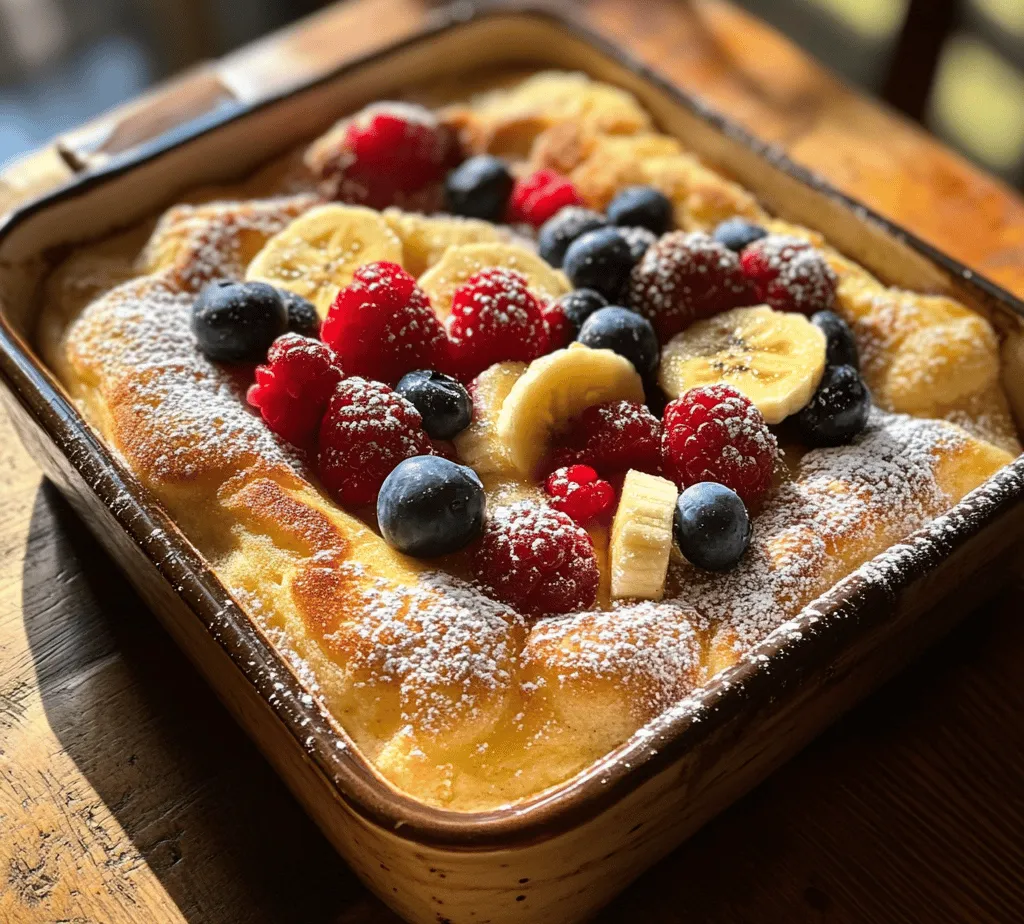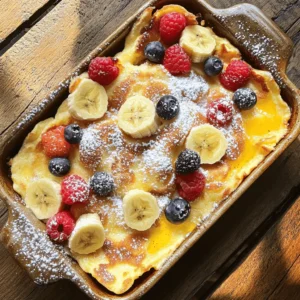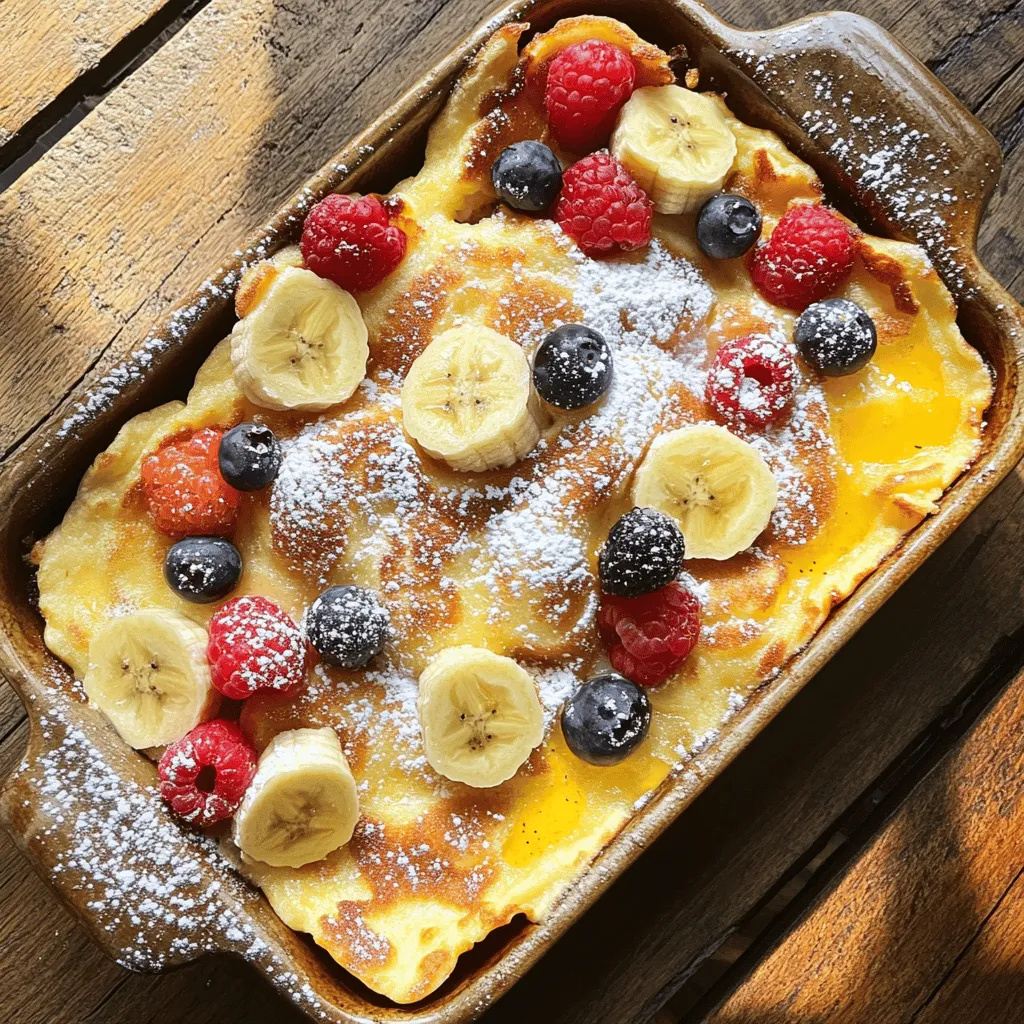Introduction
If you’re looking for a breakfast dish that combines simplicity with a touch of elegance, look no further than the baked German pancake. This delightful creation, often referred to as a Dutch baby pancake, has been winning hearts (and stomachs) since its inception. Originating from Germany, this pancake is characterized by its impressive rise and airy texture, making it a standout choice for brunch gatherings or leisurely family breakfasts.
The baked German pancake’s rise in popularity can be attributed to its unique preparation method, which involves blending ingredients and baking them in the oven, resulting in a fluffy, puffy pancake that is as visually stunning as it is delicious. Unlike traditional pancakes that require flipping and constant attention on the stovetop, the baked German pancake can be prepared with minimal fuss, allowing you to spend more time enjoying your meal and less time cooking. Its versatility also shines through in its ability to be dressed up with a variety of toppings, from fresh fruit to sweet syrups, making it a customizable dish that can cater to diverse tastes.
The appeal of the baked German pancake lies not only in its fluffiness but also in its ease of preparation. With just a few basic ingredients and a simple baking process, you can create a show-stopping dish that will impress your family and friends. In this article, we will delve into the origins of the baked German pancake, explore its cultural significance, highlight its key ingredients, and guide you through the step-by-step process of making this delightful dish.
Understanding the Baked German Pancake
Historical Background of German Pancakes
The baked German pancake has a rich history that dates back to the 19th century. While its exact origins are somewhat murky, it is widely believed that the dish was inspired by traditional German recipes for Pfannkuchen, a type of pancake that is often thicker and fluffier than its American counterpart. German immigrants brought these pancake recipes to the United States, where they evolved into the baked German pancake we know today.
As the dish gained popularity in America, it became a staple in many households, particularly in regions with a strong German influence. Its unique preparation method, which involves baking the batter in a hot oven, results in a pancake that puffs dramatically and creates a beautiful presentation. This transformation from flat batter to a towering, airy pancake is a key characteristic that distinguishes the baked German pancake from its traditional counterparts.
Differences Between German Pancakes and Traditional Pancakes
While both German pancakes and traditional pancakes share similar ingredients, such as flour, eggs, and milk, their preparation and final textures set them apart. Traditional pancakes are typically cooked on a skillet or griddle, resulting in a flat, round shape that is often served in stacks. In contrast, baked German pancakes are poured into a hot baking dish and baked in the oven, allowing them to rise and puff up dramatically.
The texture of a baked German pancake is light and airy, with a custard-like interior and a slightly crisp exterior. This unique texture is achieved through the use of a higher egg-to-flour ratio, which contributes to the pancake’s fluffiness. The baking process also creates a beautiful golden-brown color and an impressive rise that makes the dish visually appealing.
Cultural Significance and Variations Around the World
The baked German pancake has made its mark not only in Germany but also across various cultures, leading to numerous regional variations. In the United States, it is often served as a breakfast or brunch dish, typically topped with powdered sugar, fresh fruits, or syrups. In contrast, in Germany, Pfannkuchen may be served savory, filled with ingredients like cheese, ham, or vegetables, showcasing the dish’s versatility.
In other countries, similar baked pancake variations can be found. For instance, the Dutch have their own version called “Dutch baby,” which is typically baked with apples and cinnamon. In Scandinavia, a similar dish known as “klippfisk” is often enjoyed, featuring a combination of eggs, flour, and fish. These diverse interpretations highlight the global appeal of the baked pancake and its ability to adapt to local tastes and ingredients.
Ingredient Spotlight
To create a perfectly fluffy baked German pancake, you’ll need a few key ingredients that work in harmony to achieve the desired texture and flavor. Here’s a closer look at each ingredient and its role in this delightful recipe.
– Eggs: The star of the show, eggs are vital for creating the pancake’s fluffiness. They provide structure and stability to the batter while also contributing to its rise during baking. The air trapped in the eggs expands when heated, leading to the pancake’s airy texture.
– Whole Milk: Whole milk is essential for adding moisture and richness to the batter. The fat content in whole milk enhances the pancake’s flavor and contributes to a tender texture. For a lighter version, you can substitute with low-fat milk, but keep in mind that this may slightly alter the richness.
– All-Purpose Flour: This ingredient is the backbone of the pancake, providing the necessary structure. All-purpose flour offers the right balance of protein to give the pancake its height without making it too dense.
– Vanilla Extract: Adding a splash of vanilla extract enhances the overall taste, imparting a warm, sweet aroma that elevates the pancake. It’s a simple ingredient that makes a significant difference in flavor.
– Salt: A pinch of salt is crucial for balancing flavors and enhancing the sweetness of the pancake. It helps to bring out the natural flavors of the other ingredients.
– Unsalted Butter: This ingredient is key for adding richness and flavor to the pancake. Butter also helps create a beautiful golden color and a slightly crisp edge when the pancake bakes. Opting for unsalted butter allows you to control the saltiness of the dish better.
– Optional Toppings: The beauty of the baked German pancake lies in its versatility when it comes to toppings. Seasonal fruits such as berries, apples, or peaches add a refreshing contrast to the warm pancake. A dusting of powdered sugar or a drizzle of lemon juice can brighten the flavors, while maple syrup adds a touch of sweetness.
Fresh fruit toppings not only enhance the aesthetic appeal of the dish but also provide a burst of flavor and nutrition. Berries, for instance, add a tartness that complements the sweetness of the pancake, while citrus fruits like oranges or lemons offer a bright, zesty flavor that cuts through the richness. Suggested fruit pairings may include sliced strawberries, blueberries, or caramelized apples with cinnamon, allowing you to tailor the dish to your taste preferences.
Step-by-Step Guide to Making a Baked German Pancake
Preparing Your Kitchen: Tools and Equipment Needed
Before diving into the recipe, it’s essential to gather all the necessary tools and ingredients. Here’s what you’ll need to ensure a smooth cooking process:
– Blender: A blender is ideal for mixing the pancake batter quickly and thoroughly. It helps to incorporate air into the mixture, contributing to the pancake’s fluffiness.
– 9×13 Inch Baking Dish: This size is perfect for allowing the pancake to spread out evenly and rise adequately during baking. Make sure to use a dish that is oven-safe and preferably non-stick for easy release.
– Oven Mitts: Safety first! Oven mitts will protect your hands when handling the hot baking dish, ensuring you can safely remove the pancake from the oven without injury.
With your kitchen prepared and ingredients at the ready, you’re well on your way to creating a delicious baked German pancake that will surely impress. The next steps will guide you through the process of mixing, baking, and ultimately enjoying this delightful dish.
By understanding the background, ingredients, and preparation tools for the baked German pancake, you are now equipped with the knowledge to embark on your culinary journey. Stay tuned for the continuation of this article, where we will delve into the mixing and baking process, ensuring that your pancake is as fluffy and delicious as it should be.

Preheating the Oven: Importance of Starting with a Hot Oven
Before diving into the actual baking process, it is crucial to preheat your oven to 425°F (220°C). This step is not just a formality; it plays a significant role in achieving that characteristic puffiness of the German pancake. A hot oven creates steam, which helps the batter to rise dramatically during the first few minutes of baking. This initial burst of heat transforms your mixture into a delightful, airy pancake rather than a dense one.
Ensure that your oven is properly preheated before placing the pancake in. If you’re using a conventional oven, this might take about 15-20 minutes. A well-preheated oven sets the stage for a successful baking experience, so don’t skip this step!
Blending the Batter: Techniques for Achieving the Perfect Consistency
When it comes to blending the batter for your baked German pancake, consistency is key. Start by gathering all your ingredients: eggs, milk, flour, sugar, and salt. It’s best to use room-temperature eggs and milk to achieve a smoother batter. Room temperature ingredients blend more uniformly than cold ingredients, which can lead to lumps in your batter.
To achieve the perfect consistency, use a blender or an electric mixer on medium speed. This will incorporate air into the mixture, contributing to the fluffiness of the pancake. Blend for about 30-60 seconds until the batter is smooth and slightly frothy. Avoid over-blending, as this can lead to a tougher texture. Just blend until you see no lumps—this will ensure your pancake is light and airy.
Preparing the Baking Dish: Ensuring Even Cooking with Melted Butter
Once your batter is ready, it’s time to prepare the baking dish. A 9×13-inch glass or metal baking dish works well for this recipe. Begin by preheating your oven, as mentioned earlier, and while it heats, take a moment to prepare your dish.
Melt about 4 tablespoons of unsalted butter in the baking dish. You can do this by placing the dish in the oven as it preheats or melting the butter in the microwave. Once melted, swirl the butter around to coat the bottom and sides of the dish evenly. This not only prevents sticking but also contributes to a beautifully golden crust. The hot butter will also help the pancake to rise and achieve that desirable puffiness.
Baking Process: Monitoring the Pancake for Doneness
Pour the batter into the prepared dish, and immediately place it in the preheated oven. The baking process is relatively quick, typically taking around 20-25 minutes. Keep an eye on your pancake as it bakes; you’ll notice it puffing up impressively around the edges.
To check for doneness, look for a golden-brown color on the edges and a slight jiggle in the center. If the pancake is too jiggly, it likely needs more time; however, be careful not to overbake, as this can lead to a dry texture. The edges should be well-risen, and the center should be set but soft.
Signs of a Perfectly Baked Pancake
A perfectly baked German pancake will have a golden-brown color, puffy edges, and a slightly softer center. As it cools, it will settle a bit, which is normal. If you want to impress your guests, consider serving it immediately upon removing it from the oven, as it looks most spectacular at this stage. Remember, the beauty of this dish lies in its height and airy texture, so don’t let it linger too long before serving.
Serving Suggestions
Now that your baked German pancake is perfectly cooked, it’s time to think about serving it. This dish can be enjoyed in numerous ways, making it a versatile addition to your brunch or breakfast table.
– Creative Ways to Serve: Serve the pancake directly from the baking dish for a rustic feel, or slice it into squares for individual servings. Consider garnishing with fresh herbs or edible flowers for a unique touch.
– Dusting with Powdered Sugar: For an elegant presentation, lightly dust the top of your pancake with powdered sugar. This simple step adds visual appeal and a touch of sweetness.
– Using Lemon Juice vs. Maple Syrup: The choice between lemon juice and maple syrup can significantly influence the flavor profile of your dish. Freshly squeezed lemon juice adds a bright, tangy contrast that cuts through the richness of the pancake, while maple syrup provides a sweet, comforting flavor. You can offer both options on the side for guests to customize their experience.
– Incorporating Seasonal Fruits: Fresh fruits not only enhance the aesthetic of your dish but also boost its nutritional value. Consider serving the pancake with berries, sliced peaches, or apples, depending on the season. The natural sweetness of the fruits complements the pancake beautifully.
– Presentation Ideas for Special Occasions: For special occasions, consider layering the pancake with whipped cream, fresh fruit, and a drizzle of syrup for a decadent dessert-like breakfast. You could even create a themed brunch by pairing it with complementary dishes, such as a fruit salad or yogurt parfait.
Nutritional Information
Understanding the nutritional profile of your baked German pancake can help you make informed choices, especially if you’re serving it to a group with varying dietary needs.
– Breakdown of Calories and Nutrients Per Serving: A single serving of a baked German pancake (approximately one-sixth of the dish) contains around 200-250 calories, depending on the specific ingredients used. It typically includes about 8 grams of protein, 10 grams of fat, and 25 grams of carbohydrates.
– Health Benefits of Key Ingredients: The eggs provide a rich source of protein and essential vitamins, while the milk contributes calcium and vitamin D. Using whole wheat flour can also increase fiber content, making the pancake more filling and nutritious.
– Considerations for Dietary Restrictions: If you have guests with dietary restrictions, there are ways to modify this recipe. For a gluten-free option, substitute regular flour with a gluten-free baking mix or almond flour. You can also replace cow’s milk with almond or oat milk for lactose intolerance.
The Versatility of Baked German Pancakes
Baked German pancakes are incredibly versatile, making them suitable for various occasions and personal tastes.
– Customization Options: Experiment with adding spices or extracts to the batter for unique flavor profiles. A teaspoon of vanilla extract or a pinch of cinnamon can elevate the flavor of your pancake significantly.
– Variations with Chocolate, Cinnamon, or Nutmeg: For those with a sweet tooth, consider adding chocolate chips, cocoa powder, or a sprinkle of nutmeg to the batter. Each of these additions can create a deliciously different experience.
– Serving for Different Occasions: This dish isn’t just for breakfast; it can easily be enjoyed as a brunch item or even a dessert. Pair it with a cup of coffee or tea for a delightful afternoon treat.
– Storage and Reheating Tips for Leftovers: If you have leftovers, store them in an airtight container in the refrigerator for up to three days. To reheat, simply pop them in the oven at 350°F (175°C) until warmed through, or use the microwave for a quicker option.
Conclusion
This baked German pancake is not just a delightful dish; it embodies the essence of home cooking and family gatherings. Its ease of preparation combined with its impressive presentation makes it a favorite for both casual breakfasts and special occasions.
The beauty of this recipe lies in its versatility; feel free to experiment with seasonal ingredients and toppings, ensuring that each serving is unique. Whether you dust it with powdered sugar, drizzle it with syrup, or top it with fresh fruit, this pancake is sure to please everyone at the table.
Encourage your family and friends to join in the fun of creating their own versions, making this baked German pancake a delicious centerpiece for any meal. Happy cooking!



